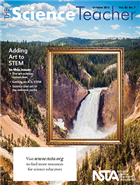Editor's Corner: Science and the Arts
By sstuckey
Posted on 2016-10-05
“The greatest scientists are always artists
as well.” —Albert Einstein
Einstein played the violin and piano, Richard Feynman the bongos. Max Planck composed songs and operas and played piano, organ, and cello. Neuroscientist Santiago Ramón y Cajal was a renowned illustrator, draftsman, and photographer. American chemist Roald Hoffmann is a published poet and playwright. These Nobel Prize winners are not isolated examples: It turns out that Nobel laureates in the sciences are 17 times likelier than the average scientist to be a painter, 12 times more likely to be a poet, and four times more likely to be a musician (Pomeroy 2012).
This should not be surprising, since science and the arts (the theme of our October 2016 issue) both spring from the same deep well of human creativity and imagination. Renaissance artists like Leonardo da Vinci and Albrecht Durer were also scientists, and the field journals and drawings of Charles Darwin and James Audubon added much to our scientific understanding of nature.
Mae Jemison—doctor, dancer, and first African-American woman in space—observes that “The arts and sciences are avatars of human creativity” (2002). The Next Generation Science Standards recognize that “Scientific knowledge is a result of human endeavor, imagination, and creativity” (NGSS Appendix H, p. 6).
The overlap of science and art can provide rich learning experiences for students. Both science and art help develop careful habits of observation, and both engage students with crosscutting concepts like patterns, scale, and proportion. Science teachers appreciate the value of artwork and creativity every time they assign a poster project, design challenge, or creative writing assignment.
Perhaps best of all, including the creative arts in science instruction can help dislodge the common misconception that science is simply a dry, tedious accumulation of facts about the world instead of the imaginative, collaborative enterprise that the history of science shows it to be. I’m in awe of the imagination required for Ernest Rutherford to propose the atomic nucleus, James Watson and Francis Crick to visualize the DNA molecule, and Einstein to develop the general theory of relativity, and for the countless other examples of scientific creativity.
Coupled with science, technology, engineering, and mathematics, art and design will drive innovation in the 21st century. Our goal should be to foster the creativity essential to both scientific and artistic ways of thinking.
Steve Metz is the Field Editor of The Science Teacher.
References
Jemison, M. 2002. Teach arts and sciences together. TED2002.
NGSS Lead States. 2013. Next Generation Science Standards: For states, by states. Washington, DC: National Academies Press.
Pomeroy, S. 2012. From STEM to STEAM: Science and art go hand-in-hand. Scientific American blog network.
Editor’s Note
This article was originally published in the October 2016 issue of The Science Teacher journal from the National Science Teachers Association (NSTA).
Get Involved With NSTA!
Join NSTA today and receive The Science Teacher,  the peer-reviewed journal just for high school teachers; to write for the journal, see our Author Guidelines and Call for Papers; connect on the high school level science teaching list (members can sign up on the list server); or consider joining your peers at future NSTA conferences.
the peer-reviewed journal just for high school teachers; to write for the journal, see our Author Guidelines and Call for Papers; connect on the high school level science teaching list (members can sign up on the list server); or consider joining your peers at future NSTA conferences.
The mission of NSTA is to promote excellence and innovation in science teaching and learning for all. Learn more about the Next Generation Science Standards at the NGSS@NSTA Hub.
Future NSTA Conferences
2016 Area Conferences
Disclaimer: The views expressed in this blog post are those of the author(s) and do not necessarily reflect the official position of the National Science Teaching Association (NSTA).



